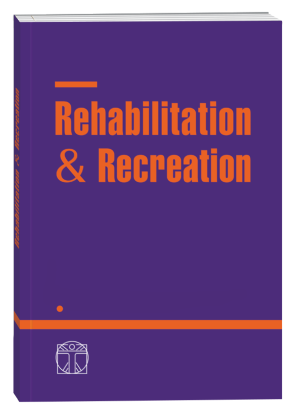EFFECTIVENESS OF CORRECTION OF SYMPTOMS OF MYOFASCIAL PAIN SYNDROME IN PERSONS WITH TEMPO-MANDIBULAR JOINT DYSFUNCTION BY PHYSICAL THERAPY MEASURES
DOI:
https://doi.org/10.32782/2522-1795.2024.18.4.3Keywords:
maxillofacial region, rehabilitation, physical therapy in dentistry, orthopedics, temporomandibular joint, joint dysfunctionAbstract
Purpose is to determine the corrective effect of the developed physical therapy program on the indicators of myofascial pain syndrome in persons with of the temporomandibular joint dysfunction. Material. 100 people were examined. The comparison group consisted of 35 people without burdened dental status. Group 1 consisted of 33 people with painful dysfunction of the temporomandibular joint, whose symptoms were corrected by wearing individually made splints on the lower jaw. Group 2 consisted of 32 individuals with temporomandibular joint pain dysfunction who wore individual relaxing splints and underwent a three-month physical therapy program. It included therapeutic exercises with the OraStretch® Press System, exercises for the face, neck, cervical region, back, breathing exercises, relaxation exercises; massage course; electromyostimulation of the muscles of the maxillofacial area; proprioceptive neuromuscular facilitation of masticatory muscles, neck muscles; kinesiological taping; progressive muscle relaxation according to Jacobson. The result was assessed by the dynamics of palpation of the tissues of the face and neck, palpation of the structures of the temporomandibular joint according to the Rocabado pain map, measurement of the chin-chest, ear-shoulder distance, and manual muscle testing. Results. In the patients, signs of myofascial disorders were determined in the form of palpable changes in the area of the masticatory muscles, the front surface of the neck and the cervical spine, which was supported by the results of palpation of the structures of the temporomandibular joint according to the Rocabado pain map, the results of measuring the chin-chest, ear-shoulder distance, manual muscle testing. The complex physical therapy program demonstrated a statistically significant better effect (p<0.05) on the studied indicators compared to the initial data. A group of patients who underwent rehabilitation with the use of passive splint therapy did not demonstrate an effect on indicators of myofascial dysfunction; the achieved improvement according to the studied parameters of the orofacial zone were statistically significantly worse than the obtained indicators of the developed and implemented physical therapy program. Conclusions. Means of physical therapy improve the effectiveness of dental orthopedic interventions, therefore, it is advisable to use them to increase the effectiveness of correction, reduce the severity of pathological signs, and improve functioning in patients with painful dysfunction of the temporomandibular joint.
References
1. Alowaimer H.A., Al Shutwi S.S., Alsaegh M.K., et al. Comparative Efficacy of Non-Invasive Therapies in Temporomandibular Joint Dysfunction: A Systematic Review. Cureus. 2024. No. 16(3). e56713. doi: 10.7759/cureus.56713.
2. Aravitska M.H., Saienko O.V. The influence of physical therapy on indicators of locomotive syndrome in elderly persons with osteoarthritis of the knee and obesity. Clinical and Preventive Medicine. 2023. 4(26). 6–13. https://doi.org/10.31612/2616-4868.4(26).2023.01.
3. Beaumont S., Garg K., Gokhale A., Heaphy N. Temporomandibular Disorder: a practical guide for dental practitioners in diagnosis and management. Aust Dent J. 2020. No. 65(3). Р. 172–180. doi:10.1111/adj.12785.
4. Bouloux G.F., Chou J., Di Fabio V., et al. The Contemporary Management of Temporomandibular Joint Intra-Articular Pain and Dysfunction. J Oral Maxillofac Surg. 2024. No. 82(6). Р. 623–631. doi: 10.1016/j.joms.2024.01.003.
5. Didokha I.V., Aravitska M.G., Yatsiv Ya.M., Hrecheskyi O.V. Effect of a physical therapeutic intervention on locomotive syndrome in the elderly patients with Parkinson’s disease and sarcopenia. Health, sport, rehabilitation. 2023. 9(1). 55–68. https://doi.org/10.34142/HSR.2023.09.01.05
6. Espinoza S., Varela D., Richter C., Sepúlveda G., Marfull N. Reproducibility of the Rocabado pain map. Cranio. 2023. No. 41(2). Р. 112–118. doi: 10.1080/08869634.2020.1816038.
7. Fernández-de-Las-Peñas C., Von Piekartz H. Clinical Reasoning for the Examination and Physical Therapy Treatment of Temporomandibular Disorders (TMD): A Narrative Literature Review. J Clin Med. 2020. No. 9(11). Р. 3686. doi: 10.3390/jcm9113686.
8. Hislop H., Avers D., Brown, M. Daniels and Worthingham’s Muscle Testing: Techniques of Manual Examination: Principles of Manual Muscle Testing. Elsevier Health Sciences, Amsterdam, 2013.
9. Koval N.P., Aravitska M.H. Dynamics of kinesiophobia and physical functioning parameters in the elderly adults with sarcopenic obesity under the influence of the physical therapy program. Clinical and Preventive Medicine. 2023. 4(26). 88–95. https://doi.org/10.31612/2616-4868.4(26).2023.13.
10. McNeill C. Craniofacial pain – the TMJ management dilemma. CDA J. 1985. No. 13(3). Р. 34–39.
11. Nesterchuk N.Ye., Gamma T.V., Korobkova R.M. Characteristics of the quality of life of elderly patients with traumatic damage of the lower jaw as a criterion of the efficiency of rehabilitation intervention. Rehabilitation & Recreation. 2024. No. 18 (2). Р. 20–27. https://doi.org/10.32782/2522-1795.2024.18.2.2.
12. Pérez Fernández T., Parra González Á. Physiotherapy in temporomandibular disorder, chapter 7: local valuation. Barcelona, Spain : Elsevier; 2019. Р. 110–114.
13. Sosa G.E. Early detection of temporomandibular disorders, chapter VII. Caracas, Venezuela : Amolca; 2006. Р. 176–179. 6 S. ESPINOZA ET AL.
14. Tran C., Ghahreman K., Huppa C., Gallagher J.E. Management of temporomandibular disorders: a rapid review of systematic reviews and guidelines. Int J Oral Maxillofac Surg. 2022. No. 51(9). Р. 1211–1225. doi: 10.1016/j.ijom.2021.11.009.
15. Wadhokar O.C., Patil D.S. Current Trends in the Management of Temporomandibular Joint Dysfunction: A Review. Cureus. 2022. No. 14(9). e29314. doi: 10.7759/cureus.29314.
Downloads
Published
How to Cite
Issue
Section
License

This work is licensed under a Creative Commons Attribution-NonCommercial-NoDerivatives 4.0 International License.












